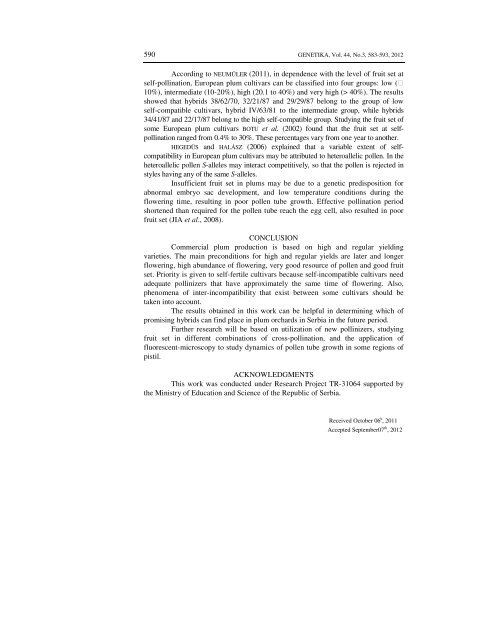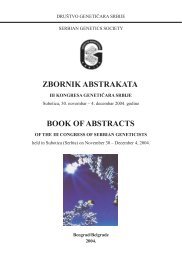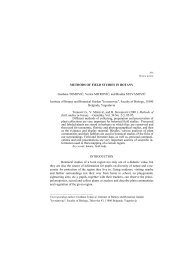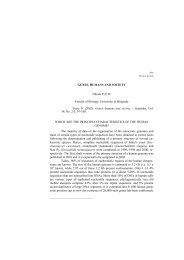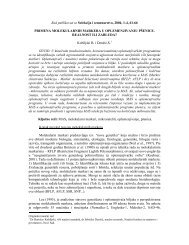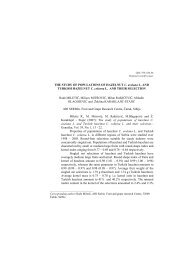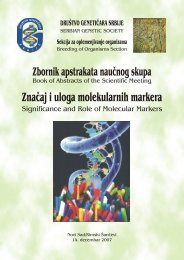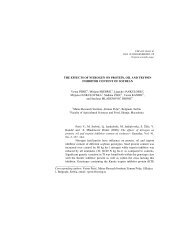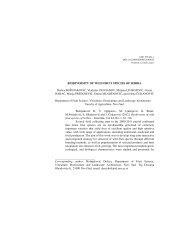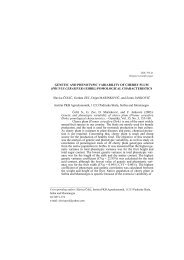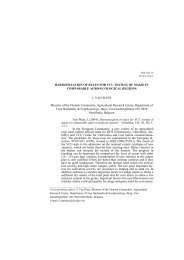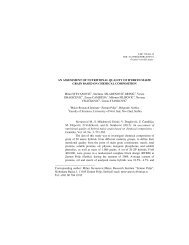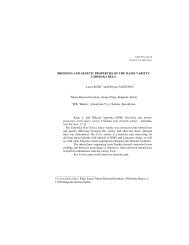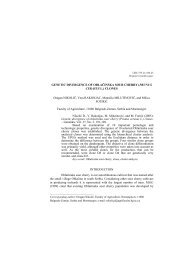Initial and final fruit set in some plum (Prunus domestica L.) hybrids ...
Initial and final fruit set in some plum (Prunus domestica L.) hybrids ...
Initial and final fruit set in some plum (Prunus domestica L.) hybrids ...
Create successful ePaper yourself
Turn your PDF publications into a flip-book with our unique Google optimized e-Paper software.
590 GENETIKA, Vol. 44, No.3, 583-593, 2012<br />
Accord<strong>in</strong>g to NEUMÜLER (2011), <strong>in</strong> dependence with the level of <strong>fruit</strong> <strong>set</strong> at<br />
self-poll<strong>in</strong>ation, European <strong>plum</strong> cultivars can be classified <strong>in</strong>to four groups: low (˂<br />
10%), <strong>in</strong>termediate (10-20%), high (20.1 to 40%) <strong>and</strong> very high (> 40%). The results<br />
showed that <strong>hybrids</strong> 38/62/70, 32/21/87 <strong>and</strong> 29/29/87 belong to the group of low<br />
self-compatible cultivars, hybrid IV/63/81 to the <strong>in</strong>termediate group, while <strong>hybrids</strong><br />
34/41/87 <strong>and</strong> 22/17/87 belong to the high self-compatible group. Study<strong>in</strong>g the <strong>fruit</strong> <strong>set</strong> of<br />
<strong>some</strong> European <strong>plum</strong> cultivars BOTU et al. (2002) found that the <strong>fruit</strong> <strong>set</strong> at selfpoll<strong>in</strong>ation<br />
ranged from 0.4% to 30%. These percentages vary from one year to another.<br />
HEGEDÜS <strong>and</strong> HALÁSZ (2006) expla<strong>in</strong>ed that a variable extent of selfcompatibility<br />
<strong>in</strong> European <strong>plum</strong> cultivars may be attributed to heteroallelic pollen. In the<br />
heteroallelic pollen S-alleles may <strong>in</strong>teract competitively, so that the pollen is rejected <strong>in</strong><br />
styles hav<strong>in</strong>g any of the same S-alleles.<br />
Insufficient <strong>fruit</strong> <strong>set</strong> <strong>in</strong> <strong>plum</strong>s may be due to a genetic predisposition for<br />
abnormal embryo sac development, <strong>and</strong> low temperature conditions dur<strong>in</strong>g the<br />
flower<strong>in</strong>g time, result<strong>in</strong>g <strong>in</strong> poor pollen tube growth. Effective poll<strong>in</strong>ation period<br />
shortened than required for the pollen tube reach the egg cell, also resulted <strong>in</strong> poor<br />
<strong>fruit</strong> <strong>set</strong> (JIA et al., 2008).<br />
CONCLUSION<br />
Commercial <strong>plum</strong> production is based on high <strong>and</strong> regular yield<strong>in</strong>g<br />
varieties. The ma<strong>in</strong> preconditions for high <strong>and</strong> regular yields are later <strong>and</strong> longer<br />
flower<strong>in</strong>g, high abundance of flower<strong>in</strong>g, very good resource of pollen <strong>and</strong> good <strong>fruit</strong><br />
<strong>set</strong>. Priority is given to self-fertile cultivars because self-<strong>in</strong>compatible cultivars need<br />
adequate poll<strong>in</strong>izers that have approximately the same time of flower<strong>in</strong>g. Also,<br />
phenomena of <strong>in</strong>ter-<strong>in</strong>compatibility that exist between <strong>some</strong> cultivars should be<br />
taken <strong>in</strong>to account.<br />
The results obta<strong>in</strong>ed <strong>in</strong> this work can be helpful <strong>in</strong> determ<strong>in</strong><strong>in</strong>g which of<br />
promis<strong>in</strong>g <strong>hybrids</strong> can f<strong>in</strong>d place <strong>in</strong> <strong>plum</strong> orchards <strong>in</strong> Serbia <strong>in</strong> the future period.<br />
Further research will be based on utilization of new poll<strong>in</strong>izers, study<strong>in</strong>g<br />
<strong>fruit</strong> <strong>set</strong> <strong>in</strong> different comb<strong>in</strong>ations of cross-poll<strong>in</strong>ation, <strong>and</strong> the application of<br />
fluorescent-microscopy to study dynamics of pollen tube growth <strong>in</strong> <strong>some</strong> regions of<br />
pistil.<br />
ACKNOWLEDGMENTS<br />
This work was conducted under Research Project TR-31064 supported by<br />
the M<strong>in</strong>istry of Education <strong>and</strong> Science of the Republic of Serbia.<br />
Received October 06 h , 2011<br />
Accepted September07 th , 2012


